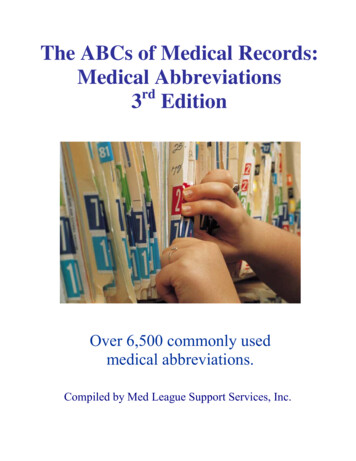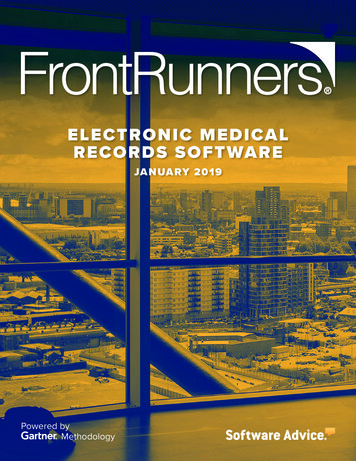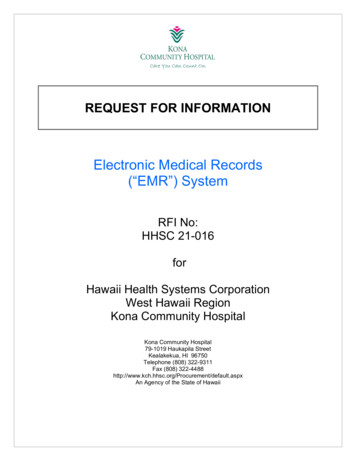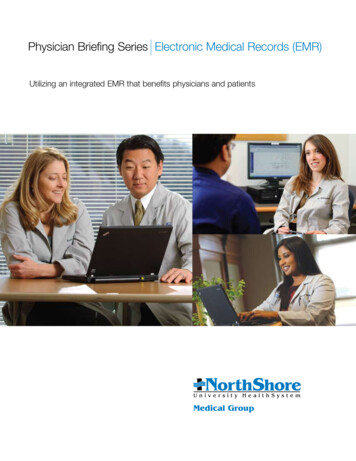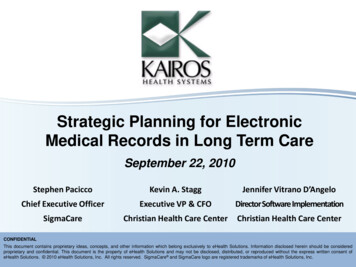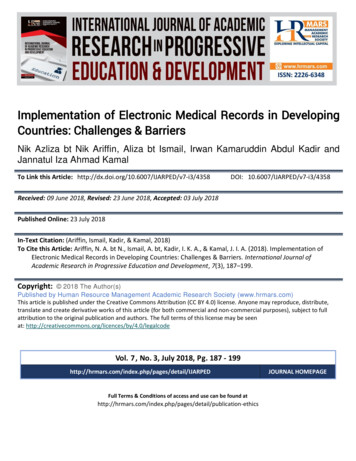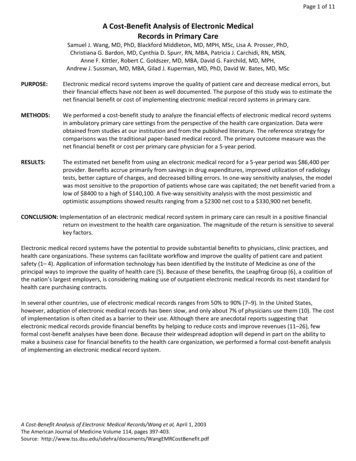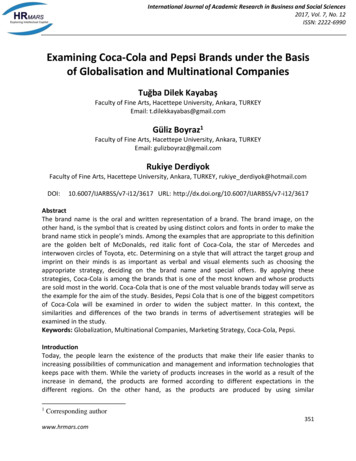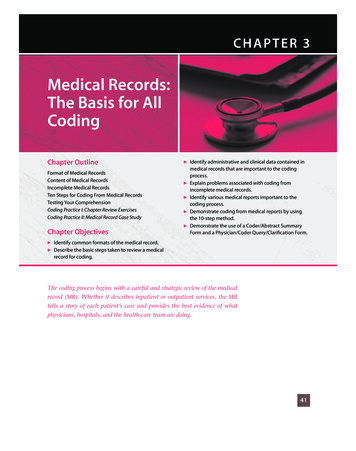
Transcription
LWBK152-C03 41-68.qxd 09/12/2008 10:37 Page 41 Aptara Inc.CHAPTER 3Medical Records:The Basis for AllCodingChapter OutlineFormat of Medical RecordsContent of Medical RecordsIncomplete Medical RecordsTen Steps for Coding From Medical RecordsTesting Your ComprehensionCoding Practice I: Chapter Review ExercisesCoding Practice II: Medical Record Case StudyChapter Objectives. Identify administrative and clinical data contained inmedical records that are important to the codingprocess. Explain problems associated with coding fromincomplete medical records. Identify various medical reports important to thecoding process. Demonstrate coding from medical reports by usingthe 10-step method. Demonstrate the use of a Coder/Abstract SummaryForm and a Physician/Coder Query/Clarification Form. Identify common formats of the medical record. Describe the basic steps taken to review a medicalrecord for coding.The coding process begins with a careful and strategic review of the medicalrecord (MR). Whether it describes inpatient or outpatient services, the MRtells a story of each patient’s care and provides the best evidence of whatphysicians, hospitals, and the health-care team are doing.41
LWBK152-C03 41-68.qxd 09/12/2008 10:37 Page 42 Aptara Inc.42PART I: Introduction to ICD-9-CMThis chapter explains and illustrates the typical structure and main contentof a conventional MR, including various medical reports, and its importance to coders. It then presents a traditional step-by-step approach toreviewing and interpreting the MR for accurate coding. This approachserves as the basic framework on which you can build as you become moreadept at coding.Medical reports contain consistent content, much of which is dictated bylaws and accrediting standards. However, from facility to facility, there is norequirement for reports to be formatted (organized or arranged) in the samemanner. Over time, information requirements have been standardizedthrough accrediting agencies such as the Joint Commission, Medicare’s Conditions of Participation, and state licensure laws. Health-care providers alsowant to collect and share data to improve their patient services by determining how some institutions can do certain things better than others (i.e.,benchmarking to improve performance). This book uses real-world examplesof medical reports, so you will see different formats from various health-carefacilities presented in this chapter’s coding exercises and in those throughoutthe book.Format of Medical RecordsThe formatting of an MR, whether paper based or electronic, can change fromone institution to another, but the contents or data remain consistent. Similarinformation is usually found, although it can be found in different placeswithin MRs from different institutions. To ensure correct coding, you shouldbe searching for data first. Knowledge of MR formatting, although helpful, isof secondary concern.Different MR formats that you may be exposed to include:. Problem-oriented MR—contains four main parts: database, problemlist, initial plans, and progress notes. This format allows a physicianto focus on the whole patient in the context of addressing all problems. Writing progress notes in the problem-oriented MR is referred toas SOAPing, which follows all problems through a structuredapproach of Subjective Objective (data), Assessment (of diagnoses),and Plan (for care). Source-oriented MR—forms are organized by departments or units (i.e.,all laboratory, x-ray, nurses’ notes, and physician’s progress notes areseparated), which allows for quick comparison of data over time (e.g.,results of lab work, x-rays, or tests). Integrated MR—integrates various forms and caregiver notes, arrangingthem in strict chronological order to allow for a quick assessment ofthe patient at any particular moment in time.Don’t worry: you do not have to become an expert at MR formatting tobecome a good coder. You do need an awareness of the data you are lookingfor. The arrangement of data within or between pages is not as important asthe information itself. Although familiarity with MR formats might help youfind data more quickly, by trial and error alone, you will soon find the dataand be able to code. You must become familiar with the data containedwithin MRs to code accurately.
LWBK152-C03 41-68.qxd 09/12/2008 10:37 Page 43 Aptara Inc.CHAPTER 3: Medical Records: The Basis for All CodingContent of Medical RecordsMRs contain administrative and clinical data that assist in the process of coding. Administrative data include routine patient identification such as thepatient’s name, age, sex, date of birth, address, religious preference, insurancedata, and consent for treatment. Clinical data include diagnoses, procedures,and results of tests such as laboratory work, x-ray studies, and operations.Although most registration data (administrative) collected at the time ofpatient admission contribute to accurate coding, the key information for coding is clinical (e.g., diagnosis of hepatitis or alcohol abuse and proceduressuch as cardiac pacemaker insertions or bowel resections).Incomplete Medical RecordsIn the real world, you often must code from incomplete records to processrecords quickly for reimbursement. Discharge summaries (DS) and otherimportant forms and information are often not yet available at the time ofcoding. Missing information can result in inaccurate coding that can causethe institution to lose money and create compliance issues (e.g., fraud andabuse), and the resulting bad data can spill over into inadequate quality-ofcare reviews to evaluate patient care concerns. According to the Joint Commission, patients’ histories and physicals (H&Ps) must be completed within24 hours, and operative reports must be completed immediately. However,the overall record must be completed within 30 days, and often DS fall withinthis time period. Coding from incomplete records will not result in 100% coding accuracy. In the face of incomplete records, you may need to query thephysician for more information or wait until an important report is available.Just as you need to get a paycheck to pay your bills, a hospital must receiveremittance (payments for services) to pay its bills. Under today’s prospectivepayment systems, an MR must be coded before billing and remittance. It isimportant that health-care professionals remain aware of the effect of incomplete and untimely physician documentation and its effect on the institution’sfinancial bottom line, performance-improvement activities (e.g., internalreviews of surgical and mortality cases), and compliance with its governinglaws. Because documentation is the basis of all coding, monitoring and actionsto improve the timeliness and quality of MR documentation must constantlybe stressed to all who are involved in the coding and billing process.Ten Steps for Coding from Medical RecordsBefore beginning the process of coding, make sure sufficient basic materialsare in place, including up-to-date ICD-9-CM codebooks, a medical dictionary,and reference books for drugs, human anatomy, and the American HospitalAssociation’s Coding Clinic. Have a scratch pad available to take notes as yougo. Make sure you have a quiet place to code and plenty of desk space. Beaware that software products such as encoders are available to help you codeand are used by many hospitals. However, before you use software, the basicsare best learned starting with the ICD-9-CM codebook. The Office of Inspector General’s Model Hospital Compliance Plan also prescribes not to rely43
LWBK152-C03 41-68.qxd 09/12/2008 10:37 Page 44 Aptara Inc.44PART I: Introduction to ICD-9-CM100% on computerized encoders and indicates that staff must have access tocoding books.1Most hospitals use hundreds of different medical report forms. This chapter does not illustrate every possible report found within a medical record, butit does introduce those most important for beginning the process of coding.The 10 steps below will give you a framework for coding from MRs.Step 1: Review Face Sheet or Registration RecordThe Face Sheet or Registration Record (Medical Report 3.1) is the front page ofthe MR. It contains basic patient identification data, insurance information,and sometimes clinical data such as the admitting and final diagnoses.What to look for:. the size of the record and the patient’s length of stay, sex, age, andadmitting diagnosis—all of which will give you insight into the complexity of the diagnosis. prospective payment system payers (e.g., Medicare), which may raisecompliance and reimbursement issuesStep 2: Review History and Physical, Emergency DepartmentReport, and/or Consultant’s ReportThe H&P Report (see Medical Report 3.2) is usually dictated by the attendingphysician and then transcribed (typed) by medical transcriptionists. The history is an important form that uncovers the chief complaint (CC) of thepatient, history of the present illness (HPI), review of systems (ROS), and personal, family, and social history (PFSH). This contains subjective data collected from the patient to begin the process of diagnosis by the physician. Thephysical examination (PE) includes a system-by-system physical examinationby the provider to collect objective data on the patient’s condition.Review the H&P to determine the chief reason(s) for admission and tobegin to get a feel for the possible options for the principal diagnosis (i.e.,“the condition, after study, chiefly responsible for occasioning the admissionof the patient to the hospital for care”) and secondary diagnoses. Review thehistory for secondary diagnoses such as comorbidities and other diagnosesaffecting patient care that need to be reported per Uniform Hospital Discharge Data Set (UHDDS) rules. Review the physical examination for abnormal findings. Altogether, the H&P enables the physician to collect both subjective and objective data on the patient to establish a provisional diagnosisand begin a plan of care for the patient.Determine the provisional or tentative diagnoses given by the physicianand plan for care. The Emergency Room or Emergency Department Reportprovides initial diagnosis and treatment information by the emergency roomphysician. If a patient is admitted through the emergency room, review thepresentation of the patient and the initial treatment or orders given. Emergency room diagnoses should be considered in the context of admittingimpressions and assessments.A Consultant’s Report (Medical Report 3.3) contains an expert opinionrequested by the attending physician to aid in the diagnosis and treatment ofthe patient. Ask what the chief reason was for the consultation request by theattending physician, and note all diagnoses given by the consulting physician.
LWBK152-C03 41-68.qxd 09/12/2008 10:37 Page 45 Aptara Inc.CHAPTER 3: Medical Records: The Basis for All CodingConsultation reports are usually dictated by the consultant and transcribed(typed) but can be handwritten as well.It is helpful to think of these reports as a connected set; that is, eachreport that comes from a different physician serves a similar function, whichis to assess the patient and begin a plan of care. Often, coders forget to reviewan emergency room record that may in fact have more detail than the attending physician’s H&P.Step 3: Review Operative Reports, Special Procedure Reports,and/or Pathology ReportsThe Operative Report is usually dictated by the surgeon or physician and thentranscribed (typed). If applicable, go to the operative report to note operations/procedures and the preoperative and postoperative diagnoses (Medical Report3.4). Depending on whether it is a major operation or a minor procedure, it isbest to recognize that MR forms related to operations or special proceduresusually exist as a set of linked forms. This operative set includes the operativereport itself, the anesthesia record, special consents for surgery, the recoveryroom record, and pathology reports for specimen analysis.Note the results of special procedures such as cardiac catheterizations,colonoscopies (lower endoscopies), esophagogastroduodenoscopies (upperendoscopies), and bronchoscopies, with or without biopsies.Remember to sequence “definitive before diagnostic” procedure codes perUHDDS rules.Note pathologic diagnoses given for any specimens removed at operationthat are usually dictated by the pathologist and then transcribed (typed).Step 4: Review Physician’s Progress NotesPhysician’s progress notes (Medical Report 3.5) need to be taken as often asthe patient’s condition warrants. Progress notes include an admit note, notesthat relate to the patient’s condition and progress, complications, response totreatment, and a discharge note. Review physician’s progress notes for significant diagnoses, findings, and resolution of problems or complications.Step 5: Review Laboratory, Radiology, and/or SpecialTest ReportsLaboratory work (Medical Report 3.6) includes several types of chemistrytests, analyses, cultures, and other examinations of body fluids or substancessuch as blood, urine, stool, and pus. Review laboratory, x-ray, and special teststo note any abnormal results and clarify treatments given through physiciandocumentation. Query the physician for added documentation if this is necessary to clarify the precise code selection.Radiology Reports (Medical Report 3.7) include x-ray studies, computedtomographic scans, nuclear medicine studies, magnetic resonance imaging,arteriograms, and so on. Review radiologic reports to note any abnormal findings and clarify through additional physician documentation within the MR(e.g., physician’s progress notes or DS).Special Test Reports (Medical Report 3.8) include electrocardiograms,echocardiograms, cardiac stress tests, and so on. Review special tests to note anyabnormal findings and clarify through additional physician documentation.45
LWBK152-C03 41-68.qxd 09/12/2008 10:37 Page 46 Aptara Inc.46PART I: Introduction to
CHAPTER 3: Medical Records:The Basis for All Coding 43 Content of Medical Records MRs contain administrative and clinical data that assist in the process of cod-ing. Administrative data include routine patient identification such as the patient’s name, age, sex, date of birth, address, religious preference, insurance data, and consent for treatment. Clinical data include diagnoses .

